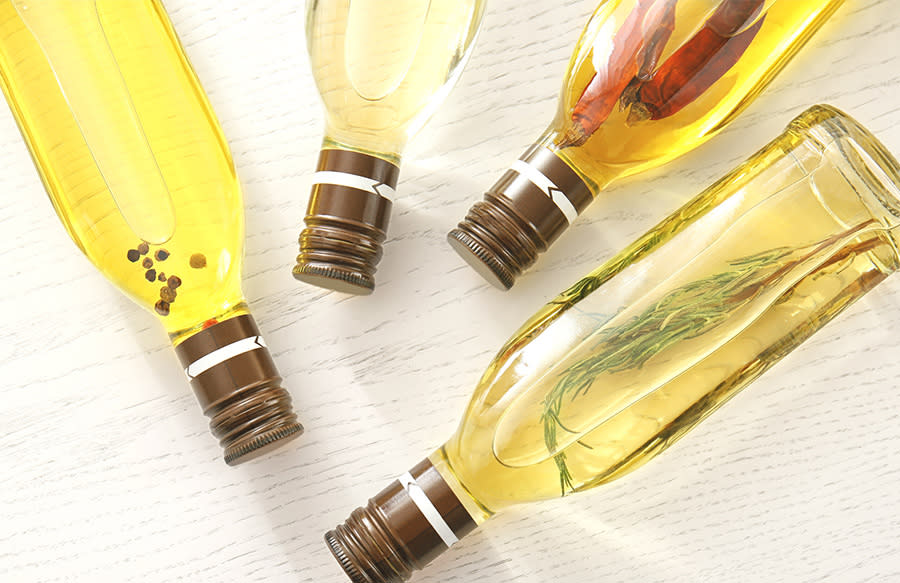Read Time: 4 min | Categories: Body Health
Your Guide to Healthy Cooking Oils
Patience Lister, BSc
Share this article
With the wide variety of cooking oils available, choosing the right one can be intimidating.
The key to choosing healthy cooking oils lies in understanding that each one has its own specific culinary and nutritional benefits. This primer on cooking oils explains the basics that will help you choose the best oils for you and your family’s meals.
Cooking Temperature
Just like the other ingredients in your recipe, your choice of oil depends on what you’re making and how you plan to cook it. The smoke point, or temperature at which an oil burns and smokes, varies with each oil.
When you heat an oil beyond its smoke point, its nutritional value and flavour can break down. In some cases, it can even generate toxins and free radicals. For this reason, you should only use medium to high smoke-point oils for higher-temperature recipes and low smoke-point oils for raw foods or drizzling over salads.
The table below outlines the smoke-point categories of common cooking oils.
Smoke-point categories of common cooking oils: [1,2,3]
| High smoke-point oils | Almond, avocado, sunflower, soybean, peanut, corn, canola | High temperature cooking, such as searing and browning |
| Medium smoke-point oils | Refined olive oil, grapeseed, coconut, sesame, extra virgin olive | Light sautéing, sauces, baking |
| Low smoke-point oils | Flaxseed, walnut, wheat germ | Finishing oils or no-cook, dressings, dips |
Nutritional Value
Even though plant oils are healthy, they are still a condensed source of fat and calories. Be sure to use them in moderation. While most contain around 120 calories and 14 g of fat per tablespoon, it is the proportions of monounsaturated, polyunsaturated, and saturated fats that differentiate them. [4]
Monounsaturated and Polyunsaturated Fatty Acids
Monounsaturated and polyunsaturated fatty acids are the main fats found in the majority of plant-derived oils. These fats are considered healthy. Good sources include:
- olive oil
- almond oil
- canola oil
- sesame oil
- safflower oil
Omega-3 Fatty Acids
Omega-3s are a type of polyunsaturated fatty acid that are essential to maintaining overall health, including heart health. But they are often lacking in many people’s diets. You can increase your omega-3 intake by consuming more oils that contain omega-3s, including:
- hemp oil
- pumpkin seed oil
- walnut oil
- organic cold pressed flaxseed oil
Saturated Fats
Saturated fats are controversial. While usually considered unhealthy, saturated plant oils with high concentrations of medium-chain triglycerides (MCTs), such as coconut oil and red palm oil, are healthy exceptions.
Oil Quality
Choosing which oil to buy can be tricky, but it will become much easier once you understand the terminology used on common product labels. This is also an important part of knowing how much you need to spend to get the quality you want.
Extra Virgin Oil and Virgin Oils
Extra virgin oils are unrefined and extracted from high-quality fruit or seeds without using chemicals or heat. This may be done with a press, decanter, or screw press at a low temperature, making them the highest quality oils available.
Virgin oils are extracted in a similar way but with a slightly lower quality fruit or seed, making them the second highest quality. [5] In general, the more refined an oil is, the lower its nutritional value and the more stable it becomes for cooking at high heats.
Cold Pressed Oils
Cold pressed oils are extracted from fruits or seeds using a press and without the use of heat. This process helps to retain more of the flavour, aroma, and nutrients. It can be used to make extra virgin and virgin oils.
Storing Oils
An oil that becomes oxidized will go rancid and should not be used. You can spot a rancid oil by its “off” smell and taste. To maintain the quality of your cooking oils and help prevent them from becoming oxidized, store them in dark glass bottles, away from light, and in a cool location.
The Right Oil
Choosing the right cooking oil for your recipe can have a big influence on the way it tastes and its nutritional value. While there’s no “best” cooking oil, the “best” way to use an oil is based on its own unique properties, such as fatty acid content and smoke point.
By keeping a few different oils on hand, you’ll always be prepared for cooking a variety of heart healthy, delicious foods that you’ll love.
